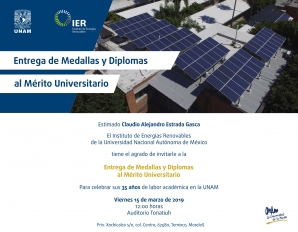Alessandro Gallo, Héctor González-Camarillo, María Isabel Roldán, Elisa Alonso, Carlos Pérez-Rábago
Abstract
In this work, the first stage of a project devoted to the evaluation of rotary kilns as thermal receivers for industrialheat production was carried out. A small-scale rotary kiln was designed, installed and tested in the IER-UNAM’s solar furnace. In the experiment, the kiln was filled with 40 g of 2-mm diameter spherical particles and it rotated at 5 rpm. The thermal equilibrium was reached after almost 2 hours of operation and a temperature of 830 ºC was achieved. In order to evaluate the irradiance distribution on the kiln aperture, an indirect estimation method was adopted. The method consists in determining firstly the Solar Furnace Factor and the incident power, and then it is calibrated the image of the irradiance distribution on a Lambertian target placed at the furnace focus. This method does not require any measurement of the irradiance on the target plane. Once the irradiance distribution was calibrated, it was compared with a ray-tracing simulated irradiance of the same system at the selected position, obtaining a maximum average deviation of 2.8%. Furthermore, a parametric analysis of the internal wall absorptance and kiln position was carried out in order to evaluate the heat-flux distribution on the kiln walls. Finally, the irradiance on the kiln walls with and without the particle bed was estimated.
Thermal Behavior and Heat-Flux Distribution in a Solar Rotary Kiln

